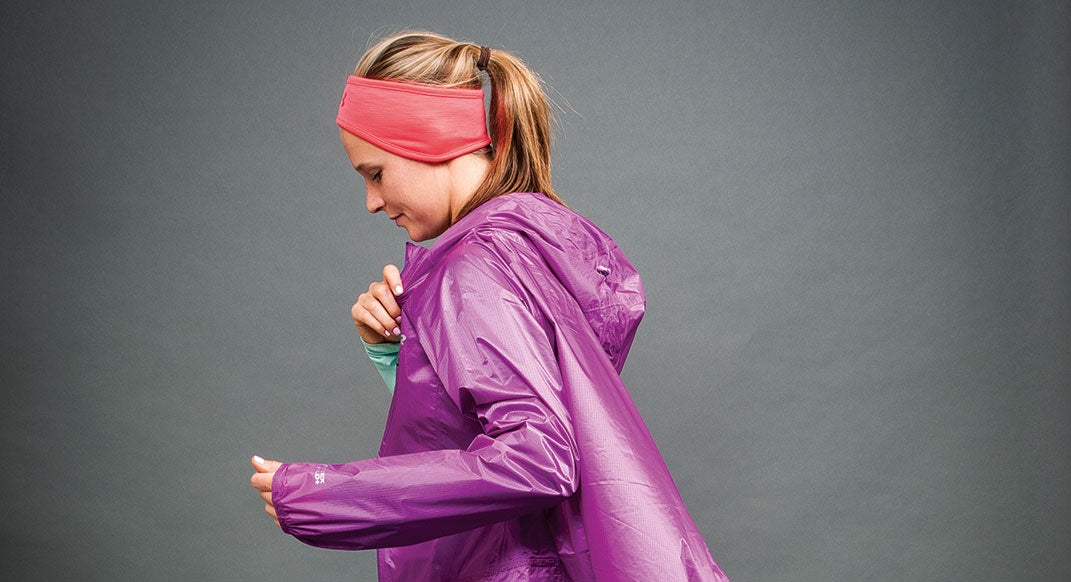The Winter Runner

But without the right gear, winter trail runs can be a drag: soaked-through shoes, falls on ice, frozen hydration, clingy layers that chill you to the bone—the list goes on. So we asked experienced runners and technical experts to take us through a few key winter-gear decisions.
Shell
DWR, WP/B, WTF?
For a versatile outer layer, go with an ultralight wind shell; they’re “big enough in performance to keep you from hypothermia, but not too bulky or non-breathable,” says ultrarunner Nick Triolo of Missoula, Montana.
Durable-water-repellent, or DWR, coating preserves breathability, but droplets “bead up and fall off the fabric” instead of saturating it, says Bennet Grimes, apparel product-line manager at Brooks. “Water will penetrate the fabric after continuous use and hard rain, but it will keep the runner dry on light-rain days or shorter runs.”
Waterproof-breathable fabrics consist of a DWR shell and an inner membrane, impervious to water but vapor permeable. Despite the name, waterproof-breathables don’t aerate enough for running except in the worst conditions—“the heaviest rains, coldest days and longest runs in rain,” says Grimes—in which long-lasting, bulletproof protection is paramount.
On clear, cold days, softshell jackets made of knit or woven polyester or nylon provide a more comfortable and breathable outer layer.
Baselayer
Wool or poly?
Most cold-weather running tops are made of merino wool
or a synthetic like polyester. Synthetics tend to be affordable, durable and highly effective at wicking sweat—keeping you dry during high-intensity activities—while soft, stretchy merino wool insulates and breathes well, regulating body temperature.
“Wool actually moves water in a vapor state” unlike synthetics, which wick condensed moisture, says Rob Thomas, a senior product-line manager at Smartwool. “The surface of your skin stays a more stable temperature.”
Though it doesn’t dry as quickly as polyester, wool retains insulating properties when wet, ideal for variable conditions and intensities, and is inhospitable to bacteria—meaning a reduced stink factor. Widely available wool-poly blends marry the thermoregulation and comfort of merino to the durability and wicking prowess of synthetics.
For next-to-skin wear, choose knit fabrics, which have more stretch and breathability, over woven, which are more durable and wind-resistant. Avoid cotton: it retains moisture and doesn’t insulate when wet.
For women runners, “The sports bra is probably the trickiest part,” says Moehl. “Once it’s wet—typically from sweat—it is detrimental to core warmth.” Look for an extra-wicking or merino-wool variety.
Pants or tights
(or, brr, shorts)?
More than anything, this comes down to personal preference. Though a few hardy souls wear shorts below freezing, most athletes switch to full, half or three-quarter tights in the 40s or high 30s. Tights provide a supportive, streamlined feel, while a running pant will appeal to those who prefer a looser fit.
When selecting a tight, says elite ultrarunner Krissy Moehl, “Look for good fit, no bunching behind the knees, and shaped to fit waist and hips. If not form fitting, they will sag and cause ‘penguin crotch.’” For extreme cold, consider thermal lining or wind panels.
Hydration
Should you insulate?
Hydration requirements don’t stop when it’s cold, but bladders and handhelds “eventually develop individual ice particles within narrow regions—hoses, cap valves, bite valves,” says Jim Frazier, VP of product at Nathan Sports. “Those particles combine and clog these narrow spaces.”
Passive insulation—foam, fabric or another insulating material—can work well down to about 20 degrees, says Frazier. For longer, colder runs, also consider active (chemical or electrical) insulation. Other strategies include drinking warm fluids, periodically blowing into the hose to keep it from freezing or stashing your hydration under a jacket—though temps can drop below freezing even within your layer system.
Spikes and GTX
or just plain old shoes?
Often, an aggressive rubber outsole provides all the winter grip you need. Says Steve Couder, VP of sales at Yaktrax, “Lugs are fine in snow for the most part, but once you hit that ice, you slide.”
For such conditions, consider a slip-on traction device. Surface makes a difference: “Small carbide spikes are the most durable and grippy for faster runs on hard icy surfaces like paved roads,” says Danny Giovale, founder of Kahtoola. “Beefier steel spikes thrive in off-road terrain, because the larger spikes dig deeper into the ground.” Coils work well on snow, but provide little bite on ice, adds Couder.
Some trail shoes come with built-in carbide studs. Or, opt for Giovale’s DIY solution: “Screws made from sheet metal and screwed into the bottom of an old pair of shoes.”
As for the snow permeating your socks, many brands produce waterproof-breathable trail shoes. Runners tend to be split on “winterized” uppers; while they keep moisture at bay longer, they reduce breathability and draining.
“I don’t think you need a waterproof shoe unless you’re doing something really extensive in winter weather—an ultra or a backpacking trip,” says Kurt. For wet but less adventurous runs, look for a non-absorbent upper material that drains well; tightly woven mesh uppers are more breathable and provide enough protection for intermittent snow. Choose your socks wisely: even soaked, wool keeps your feet warm, and an effective wicking fabric helps keep them dry.
This article originally appeared in our January 2016 issue.